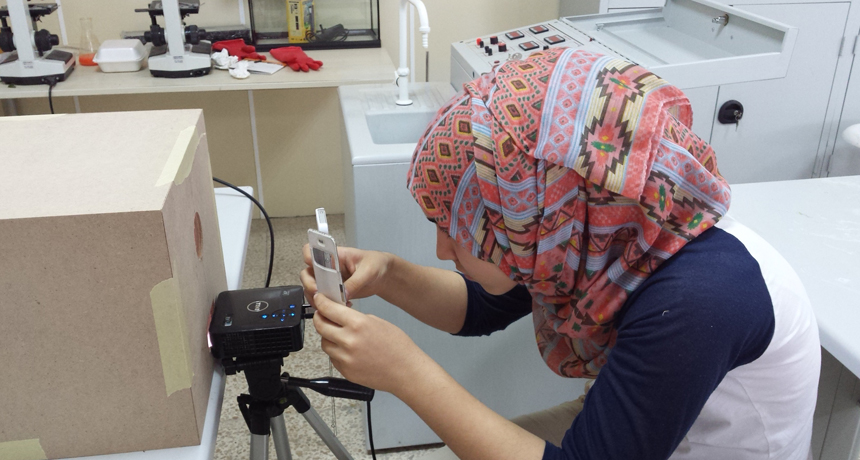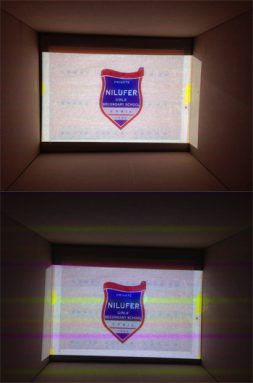Fighting theater pirates
Infrared lights placed behind a movie screen can interfere with cameras, preventing unauthorized copying of films in theaters

Research by 9th-grader Hadaia Azad Ezzulddin, from Erbil, Iraq, suggests that infrared lights embedded in theater screens could help cut down on movie piracy. Here, she tests her idea using an iPhone to take pictures of images projected onto a tiny movie screen.
Mine Gümüs
By Sid Perkins
LOS ANGELES — Cheaters called “pirates” often use camcorders and cell phones to make illegal copies of blockbuster films in the local theater. These pirates then sell those recordings on the street or over the Internet for very low prices. Some share them for free. An Iraqi teen thinks she has a simple, low-cost way to discourage movie piracy, though. It relies on adding a little unwanted light that only the pirates’ cameras will see.
“It’s unfair for people to pirate movies,” says 15-year-old Hadaia Azad Ezzulddin. The 9th-grade student attends Nilufer Girls Secondary School in Erbil, Iraq. Movie piracy “takes money out of the pockets of thousands of people in the movie industry,” she notes. Victims include famous actors and directors as well as local theater owners and their employees.
Movie piracy is a huge problem, according to data compiled by two film industry groups. One is the National Association of Theater Owners (NATO). The other is the Motion Picture Association of America (MPAA). Both are headquartered in Washington, D.C. The source of more than 90 percent of pirated films is camcording, they estimate. Such illegal recordings can be duplicated over and over.
Hadaia came up with an idea that could help stop movie piracy. It might at least make illegal copies of movies blurry and unpleasant to watch. She presented her research at the Intel International Science and Engineering Fair here on Monday, May 12. The Society for Science & the Public, which created the fair in 1950, still runs it. (SSP also publishes Science News for Students.)

To test her idea, Hadaia built a box with a movie screen inside. Then, she projected images on that screen through a hole in the box. She took recordings of those images, using nine different types of cameras. These included the types found in cell phones as well as camcorders. During some tests, she also turned on light emitting diodes, or LEDs. The LEDs were embedded in a curtain placed behind the movie screen. They emitted infrared light.
Sure enough, she showed, a pirated movie included odd stripes or spots if it had been recorded while the LEDs were on.
It might be possible to use the LEDs to flash the date and time on the movie screen, says Hadaia. That information would then appear in the illegal recordings. Theater owners or police might use that information to track down the pirates. Recordings from a theater’s security cameras, she says, might identify people who brought camera gear into the theater at that particular time. Or it could show who held phones up throughout the entire movie.
Cutting down on piracy might get more people into theaters to watch the real movie instead of an illegal copy. And that could make movies more profitable. According to the MPAA and NATO, six out of every 10 films now produced aren’t profitable. They don’t make enough money to recover how much was spent to make and market them. Such a poor payback can discourage filmmakers from producing anything but the types expected to become blockbuster hits. It might also keep smaller theaters from showing a wider variety of movie types.
Power words
electromagnetic radiation Forms of light. Electromagnetic radiation is typically classified by its wavelength. The spectrum of electromagnetic radiation ranges from radio waves to gamma rays. It also includes microwaves and visible light.
infrared light A type of electromagnetic radiation invisible to the human eye. The name incorporates a Latin term and means “below red.” Infrared light has wavelengths longer than those visible to humans. Other invisible wavelengths include X rays, radio waves and microwaves.
light emitting diodes (LEDs) Electronic components that, as their name suggests, emit light when electricity flows through them. LEDs are very energy-efficient and often can be very bright. They have lately been replacing conventional lights in auto taillights and in some bulbs used for home lighting.
sensor A device that picks up information on physical or chemical conditions — such as temperature, barometric pressure, salinity, humidity, pH, light intensity or radiation — and stores or broadcasts that information. Scientists and engineers often rely on sensors to inform them of conditions that may change over time or that exist far from where a researcher can measure them directly.







